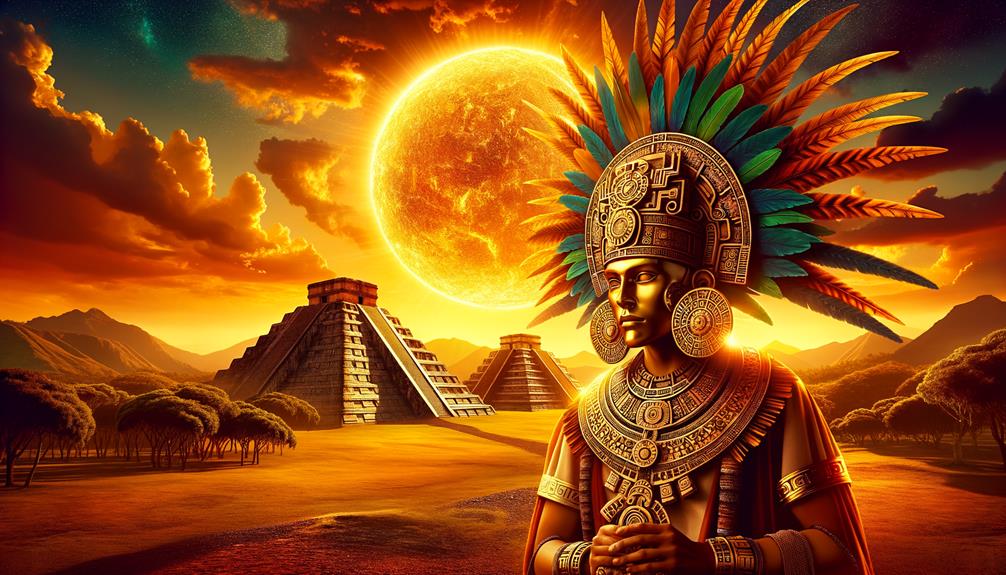The Aztec sun god Tonatiuh's mythology reflects a cosmological struggle, depicting the eternal cycle of life and death. Born as the Fifth Sun, his fiery visage adorned with human hearts reminds us of the sacrifices demanded to sustain his radiant power. Elaborate rituals aimed to maintain equilibrium and secure prosperity for the civilization.
Yet, beneath the surface, questions linger: What drove the need for such offerings? Was it a genuine belief system or a means to consolidate power? The tale of Tonatiuh offers a glimpse into an ancient worldview where maintaining balance was paramount, even if the methods seem unpalatable today.
Origins and History
Tonatiuh's tale originates from the Nahua deities and Toltec civilization, where he emerged interwoven with Quetzalcoatl, the feathered serpent associated with rain and wind. Born from sacrificial fires, Tonatiuh ascended as the fifth sun in Aztec creation stories, personifying the perpetual cycle of life and death. As the Sun god, his presence wasn't merely a celestial body providing light but a deity symbolizing strength, courage, and the warrior ethos pivotal to the Aztecs. His energy fueled their daily existence and military triumphs.
In Aztec cosmology, anthropomorphic representations depicted Tonatiuh with a fierce visage, often wielding an obsidian blade for a tongue – a grim reminder of the human sacrifices required to appease him and ensure the sun's journey. The Aztec calendar, a crucial cultural artifact, prominently featured Tonatiuh at its core, emphasizing his significance. The elaborate Sun Stone, adorned with intricate carvings, immortalized Tonatiuh as a central figure in their worldview. His narrative, woven into Aztec life, illustrates a deity whose existence was indispensable for creation and continuity, demanding reverence and sacrifice.
Myths and Legends
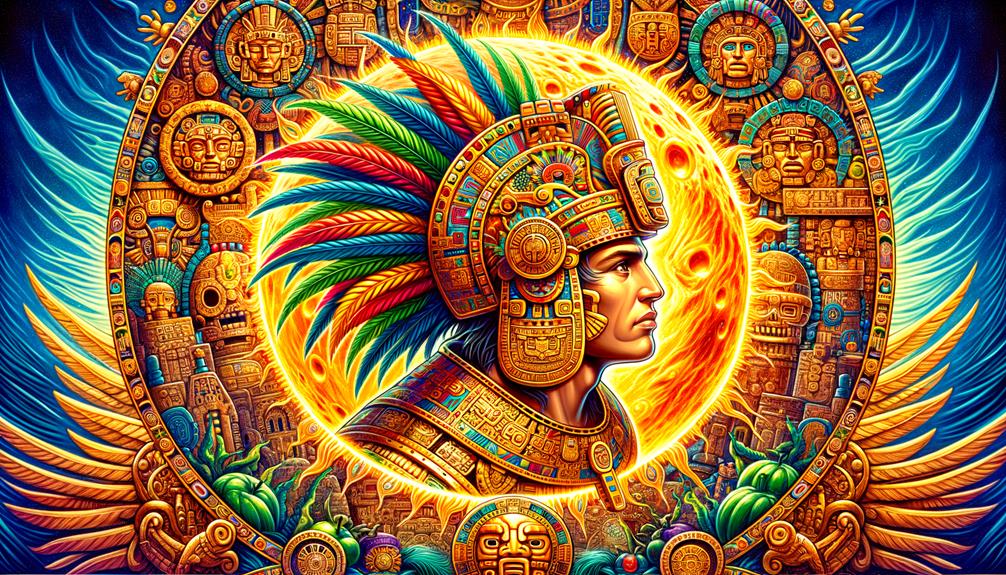
The legend of Tonatiuh, the venerated Aztec sun deity, wove a captivating narrative of heroism into their mythological tapestry. In Aztec mythology, Tonatiuh's emergence marked the Fifth Sun's dawning after the Fourth Sun's catastrophic demise. This creation myth encapsulated a hero's odyssey as the cosmos underwent cycles of destruction and rebirth. The Aztec gods convened to decide who would become the new sun, and through self-sacrifice, Tonatiuh ascended to this celestial role.
However, Tonatiuh's power depended on continuous human sacrifices. The sun god's vitality symbolized the world's vigor, and without sacrificial offerings, darkness and chaos would reign. The Aztecs believed the sun's daily journey across the sky was an unrelenting struggle, requiring nourishment through sacrifice.
Tonatiuh's myth starkly portrayed the intricate tapestry of life and death, power and sacrifice, woven into Aztec mythology. It revealed a worldview where cosmic equilibrium hinged upon the hero's unrelenting, sacrificial quest – a theme that resonated profoundly with the Aztec gods and their worshippers.
Symbolism and Imagery
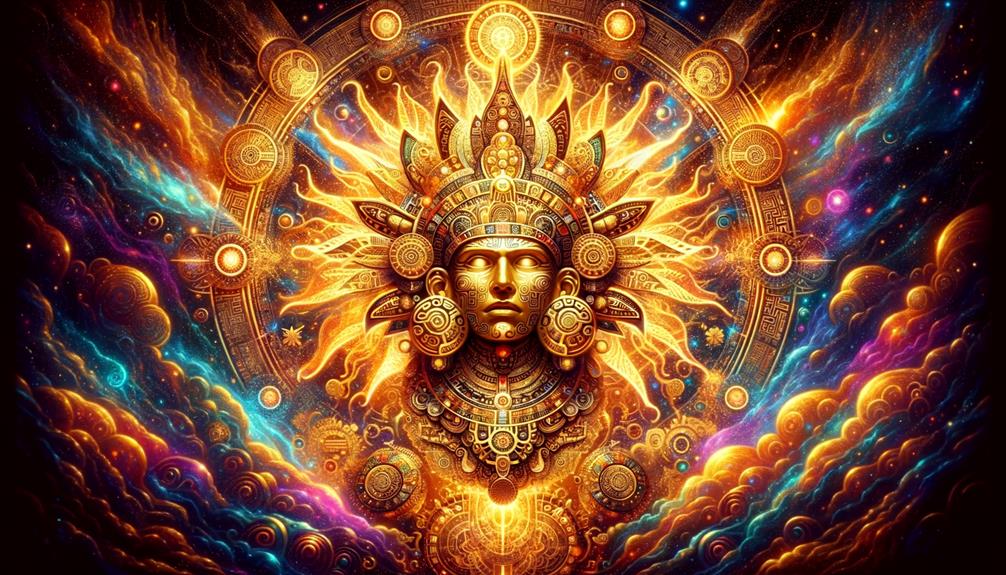
In Aztec mythology, symbols and imagery around Tonatiuh, the sun deity, center on sacrifice, cosmic balance, and divine power. Often depicted at the Aztec calendar stone's core, clutching human hearts, Tonatiuh represents the offering needed to sustain the world. This act signifies the crucial exchange ensuring life continues.
Eagle imagery ties closely to Tonatiuh, mirroring his celestial vitality and power. Radiant solar disks embody the sun god's life-giving light. Tonatiuh's fierce countenance, frequently portrayed with a flint knife tongue, underscores the sacrifices required for the cycle of life and rebirth.
In Aztec art and architecture, Tonatiuh's presence reflects his central cosmological role. Beyond just marking day's end and rebirth, his imagery illuminates the eternal balance between life and death governed by divine forces.
Rituals and Sacrifices
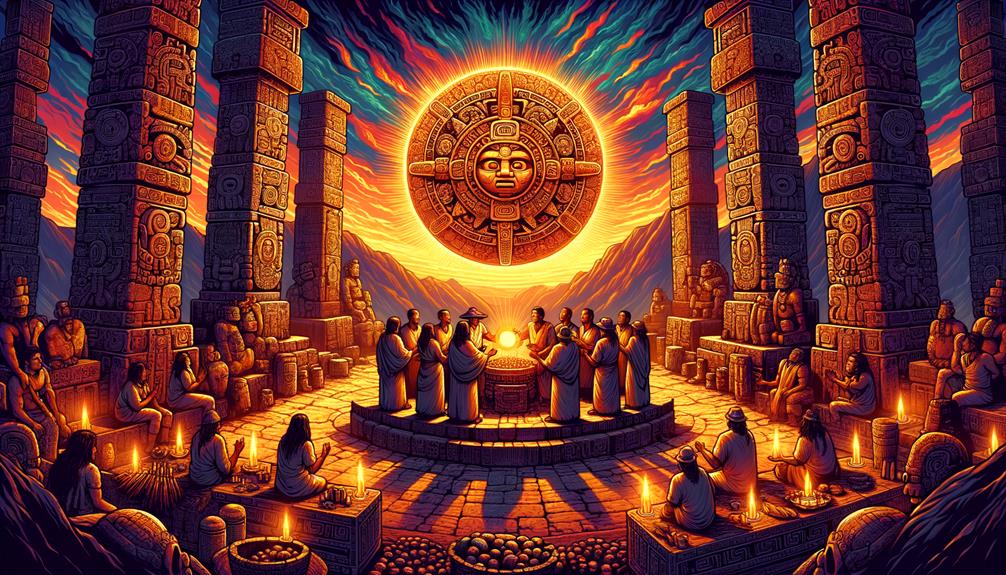
Tonatiuh, the Aztec Sun God, commanded immense reverence from the ancient Mexican civilization. Capturing warriors from rival tribes, the Aztecs performed solemn rituals, offering beating hearts to the Sun Deity. This macabre practice stemmed from their creation myth – Tonatiuh emerged as the sun's celestial ruler during the fifth cosmic age.
Elaborate temples were erected, dedicated solely to Tonatiuh. In the eyes of the Aztecs, appeasing this central deity ensured the world's prosperity. They believed gifting human hearts, symbolic of life itself, fueled Tonatiuh's power to control day and night cycles. Though unsettling from today's perspective, these bloody sacrifices represented profound devotion and a pursuit of cosmic equilibrium.
Cultural Significance
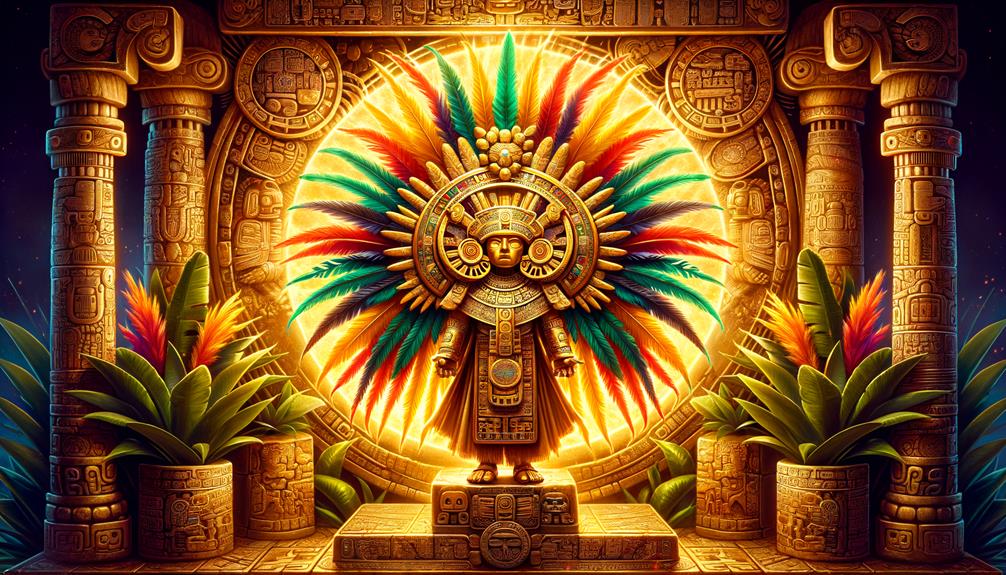
From the epicenter of the Aztec civilization, Tonatiuh's radiant presence anchored their worldview, reflecting the cyclical nature of life and death. The sun deity of the fifth era, Tonatiuh symbolized the perpetual struggle to maintain cosmic balance. This belief fueled ritualistic sacrifices as a means to sustain the sun's strength and the world's continuity.
Tonatiuh's cultural significance remains deeply woven into various aspects:
- Aztec Culture: He was a pivotal figure, representing the power and vitality of the sun—essential for agricultural prosperity and societal well-being.
- Artistic Symbolism: Mexican art often portrays Tonatiuh holding human hearts, symbolizing the sacrifices deemed necessary to preserve life and harmony.
- Mesoamerican Studies: Scholars continuously examine Tonatiuh's influence on the Aztec calendar and rituals, highlighting his role in the broader Mesoamerican cosmological context.
For the Aztec people, Tonatiuh was both the guiding light and the ultimate goal—embodying the radiance necessary for survival. His legacy resonates through contemporary Mexican culture, art, and ongoing Mesoamerican scholarly exploration.
Frequently Asked Questions
What Is the Myth About Tonatiuh?
The Fifth Sun, Tonatiuh, arose after the fourth sun's demise, according to the myth. To prevent darkness from enveloping the sky, he requires regular sacrifices to keep moving. This cyclical process of sacrifice and rebirth symbolizes life's unending cosmic journey.
Are Huitzilopochtli and Tonatiuh the Same?
Huitzilopochtli, symbolizing the ferocious warrior spirit, differed from Tonatiuh, the life-giving sun deity. These Aztec gods represented distinct cosmic aspects through their mythic roles.
What Was the Sacrifice of Tonatiuh?
The Aztecs believed sacrificing captured warriors and offering their hearts and blood gave the sun god Tonatiuh strength. These ritualistic killings ensured life's cycle continued within Aztec beliefs about the cosmos. Performing sacrifices, for them, enabled the sun's rebirth daily.
What Are the Powers of Tonatiuh?
Tonatiuh's power illuminates our world, nurturing life with warmth and sustenance. His strength inspires courage in warriors, maintaining cosmic equilibrium. Without him, the cycle of life would stumble, plunging the universe into disorder.

